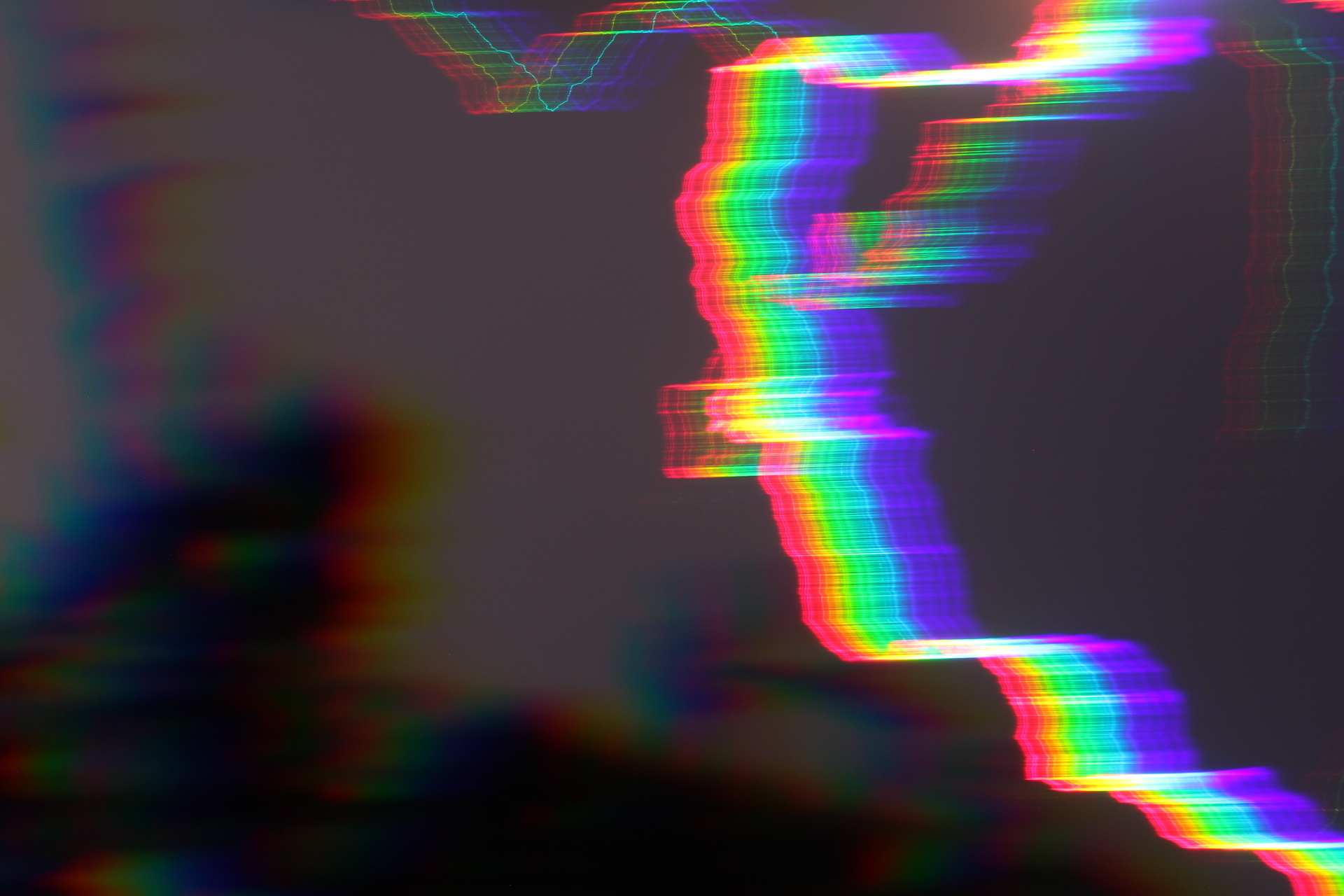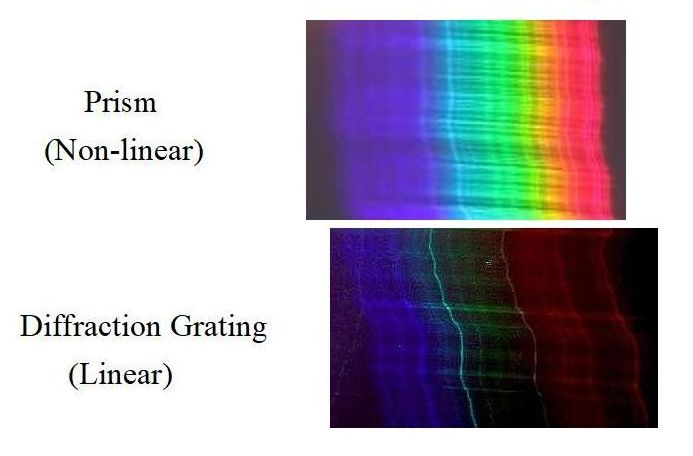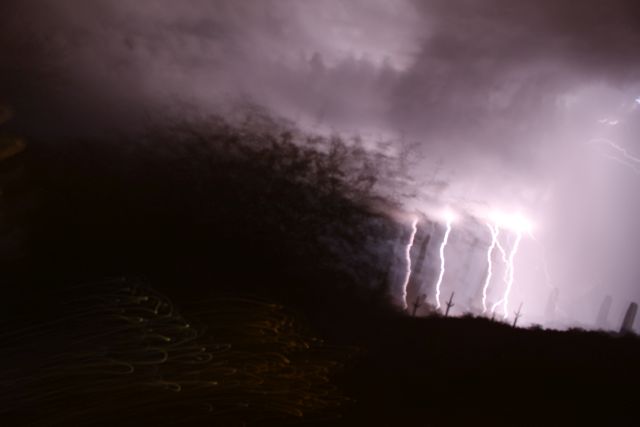Lightning
Danger! If you attempt photography of lightning, make sure you do it from a protected environment. The photographs that follow were taken from my open garage, located in the front of my home, or from my patio, which views my back yard and the foothill beyond it. Both locations are beneath the roof of my home.
Imaging Through a Transmission Diffraction Grating
I took the photograph below of lightning from my open garage at night. I put a transmission diffraction grating (transparent film) with its fine lines oriented vertically in front of the camera lens. The camera was mounted on a tripod for both stability and convenience. With this simple arrangement, the camera became a slitless spectrograph. Setting the shutter speed on "bulb," I pointed the camera toward where there was the most lightning activity and exposed for about 30 seconds. If there had not been a stroke, or if the strokes were in a different direction, I would terminate the exposure and repeat the process over and over again. The image below shows the results when luck, or shear persistence, allowed almost everything to go right.

On the above photograph the first-order emission spectrum of the lightning stroke can be seen on both sides of the image as first order spectra, with the blue diffracted at a lesser angle than the red. The bright white light, between the two first-order spectra, is called the "zero-order mode," in which there is no diffraction. The emission (bright) lines in the spectra are from atoms, ionized atoms (ions), and energetic molecules of the mixture of gasses we call "air." They are briefly at a very high temperature and are in a very strong electric current.
On the image below, the picture of the lightning stroke was taken through a transmission diffraction grating. The stroke occurred to the right of the center of the image, so, in addition to the zero-order mode, only the left first-order spectrum was recorded by the camera. Had the camera been pointing slightly to the right, both the left and right first-order spectra would have been recorded.

The photograph below shows a lightning stroke photographed through a transmission film diffraction grating. This stroke occurred on or beyond the far side of Superstition Mountain. The near edge of the mountain is located about 4 miles away from the camera. The lightning stroke is an unknown distance farther away than that.

I took the above photograph from my open garage in the front of my home.
Imaging Through a Large Glass Prism
The photo below shows a large glass prism/telephoto lens combination that I also used as a slitless spectrograph to photograph the emission spectra of lightning strokes. The large glass prism is very heavy and cannot be supported by only the lens and camera. I obtained the prism by bidding on eBay.

The telephoto lens/prism combination shown above does not have the camera body attached in this image.
The image below was taken through the telephoto lens/prism combination above. This combination is a different kind of slitless spectrograph than the transmission diffraction grating kind, so its photographic products (called spectrograms) have a very different appearance. Indeed, the spectra produced by a diffraction grating is linear, or almost linear, whereas that produced by a prism spectrograph is distinctly non-linear. This complicates the comparison of the same lines that are within the two types of spectrograms.

I took the above photograph through a large glass prism which spread the lightning stroke into its bright emission spectrum. Unlike the diffraction gratings, all the light is refracted (bent) by the prism in the same direction, but in amounts that differ according to the color (wavelength) to produce a single colorful spectrum. The red is refracted (bent) less than the blue, indicating that the actual white lightning stroke was to the left of the colorful stroke that is recorded on this image.
The image below is an enlarged view of the spectrum from the previous image.

Comparing Diffraction Grating and Prism Images
The image below shows a comparison of a scaled portion of the previous lightning spectrum (colors flipped horizontally) with a scaled portion of the first lightning spectrum on this web page. The upper spectrum on the image below was made with a prism and is non-linear in the wavelength (color) dimension along the bottom of the image, whereas the lower spectrum was made with a transmission diffraction grating and is linear in the wavelength dimension. Although the same emission lines appear on both spectra, they don't match throughout due to the differences between the linear and a non-linear representations. Relative to the linear representation, the non-linear expands the blue end and contracts the red end.

Moving Camera Images
All the images that follow were taken through a regular telephoto lens without either diffraction gratings or prisms. They differ from "regular photography" only in that the camera was hand-held and in motion (I was holding the camera in front of me and swinging my upper body left-right, right-left, left-right, etc.) with the shutter open during a night-time lightning storm. All images were taken from my open garage in the front of my home, or my covered patio in the rear of my home.

I purposely moved the camera while taking the lightning image above to show that what appears to the eye as a single sustained stroke is actually several individual strokes in rapid succession. The hand-held camera was moving from right to left when this sustained lightning stroke occurred.

For the above image, I moved the camera to show the multiple strokes of what appears to be a sustained stroke. I took this photograph from the covered patio that views my back yard and the foothill beyond it. The hand-held camera was moving from left to right.

The same for the above image, but this one was taken from my open garage in front of my home. Notice the splays (like river tributaries) on the right-most stroke, indicating that I was moving the camera from right to left when I was taking this image.
.






